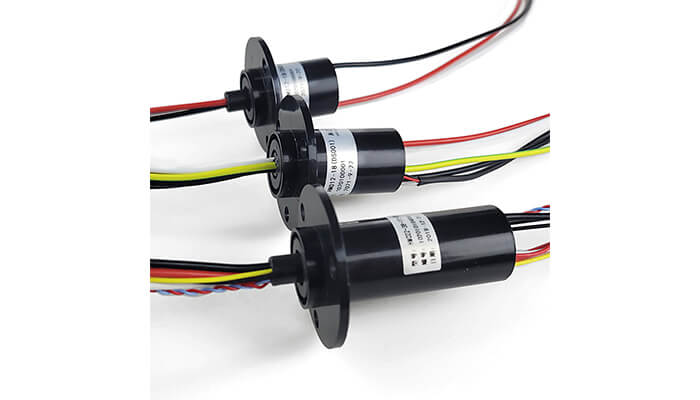Capacitive slip rings represent a significant advancement in the world of electrical engineering. Being crucial to various mechanical systems and applications, they facilitate electrical signals and power to pass from stationary to rotational parts, ensuring the smooth running of equipment. These devices offer a solution to the limitations posed by traditional slip rings, bringing low maintenance requirements, high reliability, and superior performance to the table.
This article is designed to delve deeply into the realm of capacitive slip rings, elucidating their design, functionality, and the crucial role they play in modern technology-driven environments. We will explore the science behind these components, delving into the realm of capacitance and its role in ensuring consistent and seamless operation of rotating machinery.
Readers can expect to gain a thorough understanding of capacitive slip rings, their wide-ranging usage across various industries, and vital maintenance tips to extend their lifespan and performance. The article stands as a comprehensive source, aiding in the understanding of the latest innovations and future developments in this field, enabling readers to stay abreast of the continually evolving world of technology.
Our goal is not merely to impart theoretical knowledge; rather, we aspire to translate this into practical knowledge and skills, helping to enhance the efficiency and productivity of your machinery through a more profound understanding of its integral parts. Join us on this journey as we unwrap the myriad layers of capacitive slip rings and their astounding influence on our tech-driven world.
Understanding Capacitive Slip Rings
In the realm of electrical engineering, capacitive slip rings have emerged as vital components, known for their seamless connectivity and efficient functionality in rotating systems. To comprehend their significance and contribution to our technology-dependent world, it is essential to delve deeper into the design, working principles, and the various components that constitute these devices.
A capacitive slip ring comprises a stationary part and a rotating part, facilitating the transfer of electrical signals and power between the two. At the heart of its operation lies the phenomenon of capacitance, wherein the slip ring harnesses the potential to store electrical energy temporarily in an electric field. This stored energy is utilized to enable the uninterrupted transmission of electrical signals between the rotating and stationary parts, thereby preventing wear and tear caused by physical contact and ensuring a prolonged lifespan for the components.
Furthermore, capacitive slip rings incorporate a multitude of sophisticated components, such as capacitive couplers, insulating materials, and conductive plates, each playing an integral role in their overall operation and effectiveness. These elements work in tandem, maintaining the flow of electrical energy with minimal electrical noise or interference, ultimately contributing to the overall efficiency and performance.
To facilitate a comprehensive understanding of capacitive slip rings, this article includes several diagrams, graphs, and high-quality images, meticulously chosen to depict the intricacies of their design, components, and functioning. Such visual aids are instrumental in clarifying complex concepts and bridging the gap between theory and practice, empowering readers with the knowledge that will improve the operation and maintenance of their machinery.
The Science of Capacitive Slip Rings
To fully comprehend and appreciate the exceptional efficiency of capacitive slip rings, we must delve beneath the surface and explore the underpinning principles and technology. The science behind these devices lies primarily in the phenomenon of capacitance – a fundamental principle of electrical engineering. Capacitance, in the simplest of terms, is the capacity of a system to store an electrical charge.
Capacitive slip rings, as the name suggests, employ this principle to their advantage. When housed in rotating machinery, these slip rings function as capacitors, storing energy in an electric field, created due to the difference in electrical potential between conductive plates. Through capacitive coupling, they enable the exchange of electric current between the stationary and rotating parts without any physical contact, thereby minimizing friction, wear, and tear.
Unlike traditional slip rings that rely on direct mechanical contact to transmit signals – leading to increased maintenance and risk of degradation – capacitive slip rings eliminate these drawbacks. The fundamental role of capacitance in ensuring the smooth operation of rotating machinery cannot be overstated. It eliminates the possibility of damage through continual contact, reduces electrical noise, and ensures that signal integrity is maintained, all through perpetuating uninterrupted power and signal transmission.
On the path to exploring the world of capacitive slip rings, understanding the science behind them is paramount. The principles of capacitance not only underpin their functioning but also serve as the foundation for their numerous advantages. This eases maintenance challenges and enhances longevity – making capacitive slip rings a preferred choice for engineering professionals worldwide.
Applications of Capacitive Slip Rings
The inherent versatility and robustness of capacitive slip rings have led to their widespread adoption across a vast array of industries and applications. Owing to their ability to facilitate uninterrupted power transmission and seamless communication of data over rotating interfaces, they have become a popular choice in many sectors where reliability and performance are paramount.
Let us now delve into the wide-ranging applications of capacitive slip rings, providing real-life examples that showcase the diverse domains where these devices are employed to ensure the efficiency and stability of critical systems.
Wind Turbines
In the field of alternative energy production, wind turbines use capacitive slip rings to ensure the seamless transmission of power and control signals between the stationary and rotating parts of the turbine. The slip rings are vital in maintaining the continuous communication between the generator, located in the nacelle, and the control systems on the ground.

Robotics and Automation
Capacitive slip rings play an essential role in robotics and automation sectors, particularly in complex machinery where electrical signals and power must traverse multiple axes of rotation. These slip rings ensure the smooth transmission of data between stationary control systems and rotating robotic arms or other moving components, enabling precise and efficient operation.

Medical Devices
In the medical field, capacitive slip rings are employed in a variety of devices, such as CT scanners machines and robotic surgical systems. Due to their low-noise operation and absence of physical contact, they ensure accurate, dependable, and contamination-free signal transmission, which is essential for the safe and effective use of medical equipment.

Defense and Aerospace
Capacitive slip rings are extensively used in defense and aerospace systems, where reliability and performance are of utmost importance. In applications like radar systems, satellites, and UAVs (unmanned aerial vehicles), these slip rings enable secure and efficient transfer of power, data, and control signals, significantly enhancing system performance and integrity.

Marine Applications
Capacitive slip rings are used in a variety of marine devices, such as sonar systems and shipboard communication equipment, where they facilitate efficient and dependable transfer of data across rotating interfaces in harsh environmental conditions, such as saltwater and humidity.
The examples above illustrate the versatility and value of capacitive slip rings, which have become indispensable components across numerous applications. By enabling the efficient transmission of power and data in diverse environments, these slip rings contribute significantly to advancements across various industries.

Advantages of Capacitive Slip Rings
In the journey to understand the importance of capacitive slip rings, it is vital to recognize the advantages they offer, especially when compared with traditional slip rings. The use of capacitance technology provides these devices with features that significantly enhance both the efficiency and lifespan of rotating machinery.
Reduced Wear and Tear
Unlike traditional slip rings that rely on direct mechanical contact to transmit signals, capacitive slip rings utilize the principle of capacitive coupling. This eliminates the issues of friction and leads to significantly reduced wear and tear. This not only enhances the device’s lifespan but also ensures a consistent level of performance throughout its service life.
Lower Maintenance
Capacitive slip rings are virtually maintenance-free. The requirement for lubrication or cleaning to remove dust or grime, as seen with traditional slip rings, is eliminated, making these devices a cost-effective solution for many applications.
Resistance to Harsh Conditions
Due to their non-contact nature, capacitive slip rings have considerable resilience to harsh conditions. Whether it’s high humidity, dust, or extreme temperatures, these slip rings continue to perform optimally.
High Signal Integrity
Capacitive slip rings are known for their high signal integrity. Their unique design principles reduce electrical noise, providing clearer signals and more efficient performance.
Longer Lifespan
With less physical wear and tear, capacitive slip rings showcase a longer lifespan than traditional slip rings. This contributes to a lower total cost of ownership, as replacements are needed less frequently.
Comparatively, traditional slip rings tend to wear out faster due to the continuous physical contact required, leading to more frequent maintenance and replacements. The signal quality can also degrade over time due to the accumulation of debris, an issue that capacitive slip rings effectively circumvent.
The advantages of capacitive slip rings highlight their superiority in both performance and durability, proving why more industries are opting for capacitive technology in their machinery. By understanding these benefits, individuals can make informed decisions about the most suitable type of slip ring for their specific applications.
Design and Manufacturing Process
The design and manufacturing process of capacitive slip rings is a multi-faceted endeavor shaped by years of technical innovation, precise engineering, and rigorous quality standards. It involves taking into consideration the environment and conditions under which the slip ring will operate, the type and quantity of signals that need transmission, and the specifics of the rotating equipment the slip ring will be incorporated into.
Designing Capacitive Slip Rings
The design process of capacitive slip rings starts with the selection of the right type and size of capacitive plates or electrodes that will function as the core component of the slip ring assembly. These capacitive plates are designed to store electrical charge and are responsible for the transfer of power and signals across the rotating interface. The choice of these plates is contingent on power and data transmission requirements as well as the size limitations imposed by the equipment.
Following that, the layout and assembly of the capacitive slip ring are designed. This includes determining the configuration of the capacitive plates as well as the dielectric material that separates them, which is crucial in preventing electrical discharge and allowing the storing of an electric field. These design decisions dictate the overall performance and characteristics of the capacitive slip ring.
The final design phase involves the integration of basic mechanical components into the assembly, providing structural support and enabling convenient mounting options to ease installation into the intended machinery.
Manufacturing Capacitive Slip Rings
The manufacturing process of capacitive slip rings requires expert craftsmanship and adherence to strict quality standards in order to produce a reliable and efficient product. Manufacturing involves material selection, forming, assembly, and final quality inspection.
Quality materials, such as highly conductive metals and high-performing insulators, are chosen to form the capacitive plates and the dielectric material, respectively. Once these materials are formed, the capacitive electrodes are assembled in the configured design, ensuring that each part is accurately placed to allow optimal performance.
The assembly is then encapsulated into a robust housing that protects the internal components from environmental elements and mechanical stress. The completed slip ring then undergoes rigorous testing to validate its performance and reliability before being shipped to the customer.
The Importance of Quality and Craftsmanship
The efficiency, reliability, and longevity of a capacitive slip ring hinge on the quality of its components and the craftsmanship of its manufacturing. The capacitive plates and dielectric materials must be made from high-quality materials to ensure efficient operation and resilience against environmental wear and tear. Similarly, precise assembly and robust testing are key to ensuring that the final product will perform reliably under diverse operational conditions.
In conclusion, the design and manufacturing process of capacitive slip rings is a detailed operation that requires a clear understanding of electrical principles, meticulous engineering, and stringent quality control. It is this level of commitment and precision that makes capacitive slip rings the cornerstone of effective data and power transmission across myriad applications.
Maintenance of Capacitive Slip Rings
While capacitive slip rings are designed to be low-maintenance devices, ensuring their optimal performance and longevity occasionally necessitates basic upkeep, inspection, and troubleshooting. By understanding the proper maintenance procedures and promptly addressing common issues, users can ensure that capacitive slip rings continue to perform efficiently throughout their lifespan.
Maintenance Guide
- Routine Inspection: Periodically inspect the capacitive slip ring for any visible signs of damage, such as cracks or deformation, which could be an indication of mechanical stress or excessive wear. This inspection should also look for any signs of contamination, such as dirt, dust, or moisture, which can affect the performance of the slip ring.
- Cleaning: Regularly clean the slip ring to prevent the accumulation of dust or other contaminants that could impact its efficiency. Exercise caution when cleaning and avoid using aggressive cleaning agents, as these can cause damage to the device. Instead, use a soft cloth, mild detergent, and warm water to clean the surface of the slip ring gently. Be sure to dry the slip ring thoroughly afterward to avoid trapping moisture inside the unit.
- Environmental Monitoring: Monitor the operating environment for factors that could affect the performance of your capacitive slip ring, such as excessive humidity, extreme temperatures, or corrosive substances. If the slip ring is consistently exposed to these factors, consider implementing additional protective measures, such as utilizing a sealed housing or relocating the slip ring to a less harsh environment.
- Lubrication: Although capacitive slip rings are contactless and generally do not require lubrication for their capacitive components, the mechanical bearings that facilitate rotation may call for occasional lubrication. Consult the manufacturer’s guidelines for applying the appropriate lubricant and follow the recommended lubrication schedule.
- Replacement of Parts: If your slip ring is equipped with replaceable parts, such as mechanical bearings, replace them according to the manufacturer’s recommendations or when wear and tear are evident. Regular replacement can prevent potential damage to other components within the slip ring assembly.
Troubleshooting Common Issues
- Signal Issues: If you experience intermittent signal loss or weak signal transmission, inspect the slip ring for contamination or physical damage to the capacitive plates. Clean the slip ring as necessary, or consult the manufacturer for assistance if damage is detected.
- Mechanical Noise or Vibration: Should you notice excessive mechanical noise or vibration during operation, inspect the slip ring’s bearings and housing for signs of wear or damage. Replace worn or damaged parts as needed.
- Overheating: Overheating may occur if there are issues with the slip ring’s mechanical components or if the operating environment is excessively hot. Ensure proper ventilation and consider checking the bearings for damage or insufficient lubrication.
Recommendations for Longevity
- Follow Manufacturer Guidelines: Adhere to the manufacturer’s guidelines for installation, operation, maintenance, and replacement of parts to ensure the slip ring operates optimally and lasts longer.
- Operate Within Specified Limits: Avoid operating the slip ring beyond the recommended electrical, mechanical, or environmental limits, as doing so can lead to premature failure.
- Documented Maintenance Schedule: Establish and follow a documented maintenance schedule to ensure routine inspection, cleaning, lubrication, and parts replacement is performed in a timely manner.
In summary, proper maintenance of capacitive slip rings is essential to ensure their optimal performance and longevity. By following the maintenance guide and troubleshooting common issues promptly, users can effectively preserve the efficiency and enhance the lifespan of these critical components. Regular inspection, cleaning, and adherence to the manufacturer’s guidelines contribute significantly to the reliable operation of capacitive slip rings in various applications.
Trends and Future Developments in Capacitive Slip Rings
Looking towards the future, the field of capacitive slip rings promises exciting developments and progress. These innovations hinge on advancements in technology, materials science, and an ever-evolving understanding of electrical engineering, all striving to improve the efficiency, durability, and overall performance of these critical components.
Trends in Capacitive Slip Ring Technology
- Miniaturization: The trend towards compact and lightweight machines means an increasing demand for smaller slip rings. Innovations in the field are now increasingly focused on creating high-performance capacitive slip rings with smaller footprints, known as “miniature slip rings”.
- Improved Material-Aided Performance: The continuous quest for materials with better dielectric properties, lower weight, and greater resilience against harsh conditions is shaping future developments of capacitive slip rings. Newer materials can potentially increase the performance and durability of these components.
- Integration with Advanced Systems: As the Internet of Things (IoT), Machine Learning (ML), and Artificial Intelligence (AI) evolve, the integration of capacitive slip rings with such advanced systems is expected to grow. This allows for real-time monitoring of the slip ring’s performance and predictive maintenance, thereby improving operational efficiency.
- More Energy-Efficient Designs: With the growing emphasis on energy conservation, the design of more energy-efficient slip rings is becoming a crucial objective. Future capacitive slip rings are expected to feature designs that minimize power loss during signal transmission.
Future Developments and Their Benefits
- Thermal Management: Slip rings can generate heat, especially during high-speed operation. Future designs could include advanced thermal management technologies to keep the device cool, thereby improving performance and extending the lifespan of the slip ring.
- Composite Dielectric Materials: The search for better dielectrics could lead to the development of composite materials, which combine the benefits of multiple substances to deliver better performance characteristics, including greater resilience to environmental factors, improved signal integrity, and increased lifespan.
- Smart Slip Rings: With the rise of IoT, the development of “smart” slip rings equipped with sensors could soon become a reality. These systems could monitor various parameters during operation, including temperature, humidity, vibration, and electrical load, enabling preventive maintenance and enhancing overall reliability and efficiency.
To sum up, the future of capacitive slip rings is bright, with emerging trends pointing towards improved performance, efficiency, and durability. Incremental advancements in technology alongside transformative innovations are expected to widen the application scope of these components and enhance their role in the world of rotating machinery. Understanding these trends and developments ensures users can make informed decisions when selecting and operating capacitive slip rings, thereby maximizing their benefits and potential.
Conclusion
Equipped with a comprehensive understanding of capacitive slip rings, their applications, and maintenance, it’s time to put this newfound knowledge into practice. Understanding these components helps in their optimized application, ensuring maximum efficiency of rotating machinery.
See What We Can Do

